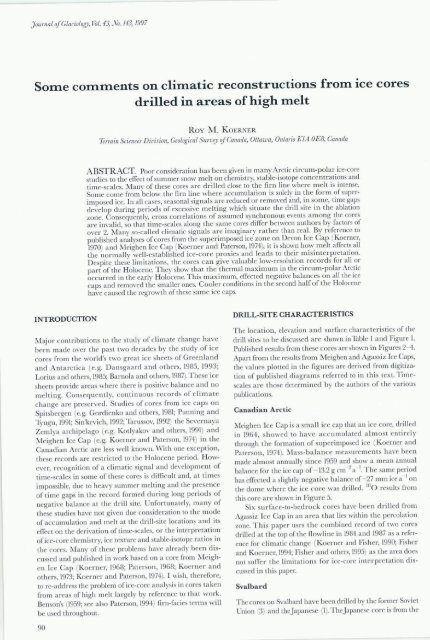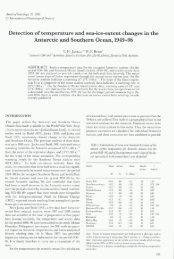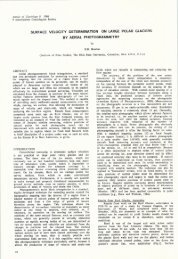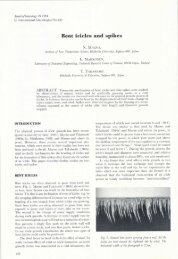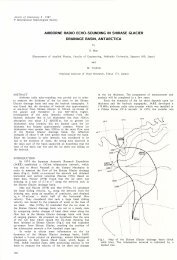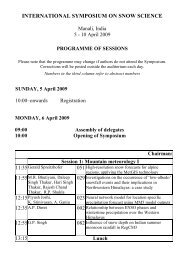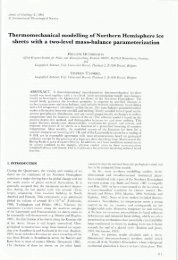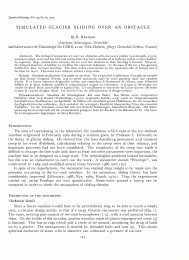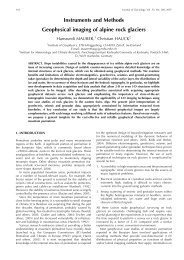Some comments on cliIllatic reconstructions froIll ice cores drilled in ...
Some comments on cliIllatic reconstructions froIll ice cores drilled in ...
Some comments on cliIllatic reconstructions froIll ice cores drilled in ...
Create successful ePaper yourself
Turn your PDF publications into a flip-book with our unique Google optimized e-Paper software.
Journal qfGlaciology, Vo!. 43, No. 143, 1997<br />
<str<strong>on</strong>g>Some</str<strong>on</strong>g> <str<strong>on</strong>g>comments</str<strong>on</strong>g> <strong>on</strong> <strong>cliIllatic</strong> rec<strong>on</strong>structi<strong>on</strong>s <strong>froIll</strong> <strong>ice</strong> <strong>cores</strong><br />
<strong>drilled</strong> <strong>in</strong> areas of high Illelt<br />
Roy M. KOERNER<br />
Terra<strong>in</strong> Sciences Divisi<strong>on</strong>, Geological SUTVey qfCanada, Ottawa, Ontario K1A OE8, Canada<br />
ABSTRACT. Poor c<strong>on</strong>siderati <strong>on</strong> has been given <strong>in</strong> many Arctic circum-polar <strong>ice</strong>-core<br />
studies to the effect of summer snow m elt <strong>on</strong> chemistry, stable-isotope c<strong>on</strong>centrati<strong>on</strong>s and<br />
time-scales. Many of these <strong>cores</strong> are <strong>drilled</strong> close to the firn l<strong>in</strong>e wh ere m elt is <strong>in</strong>tense.<br />
<str<strong>on</strong>g>Some</str<strong>on</strong>g> come from below the Grn l<strong>in</strong>e where accumulati<strong>on</strong> is solely <strong>in</strong> the form of superimposed<br />
<strong>ice</strong>. In all cases, seas<strong>on</strong>al signa ls are reduced or removed and, <strong>in</strong> some, time gaps<br />
develop dur<strong>in</strong>g periods of excessive m elt<strong>in</strong>g which situate the drill site <strong>in</strong> the ablati<strong>on</strong><br />
z<strong>on</strong>e. C<strong>on</strong>sequently, cross correlati<strong>on</strong>s of assumed sy nchr<strong>on</strong>ous events am<strong>on</strong>g the <strong>cores</strong><br />
are <strong>in</strong>valid, so that time-scales al<strong>on</strong>g the same <strong>cores</strong> differ between authors by factors of<br />
over 2. Many so-call ed climatic signals a re imag<strong>in</strong>ary ra ther than real. By reference to<br />
published a nalyses of <strong>cores</strong> from the superimposed <strong>ice</strong> z<strong>on</strong>e <strong>on</strong> Dev<strong>on</strong> Ice Cap (Koerner,<br />
1970) and Meighen Ice Cap (Koerner a nd PatersOJ1, 1974), it is shown how m elt affects all<br />
the normally well-es ta blished <strong>ice</strong>-core proxies and leads to their mis<strong>in</strong>terpretati<strong>on</strong>.<br />
D espite these limitati<strong>on</strong>s, the <strong>cores</strong> can give valuable low-resoluti<strong>on</strong> records for all or<br />
part of the Holocene. T hey show that the thermal maximum <strong>in</strong> the circum-polar Arctic<br />
occurred <strong>in</strong> the early H olocene. This m aximum, effected negative balances o n all th e <strong>ice</strong><br />
caps and removed the smaller <strong>on</strong>es. Cooler c<strong>on</strong>diti<strong>on</strong>s <strong>in</strong> the sec<strong>on</strong>d half of the H olocene<br />
have caused the rcgrowth of these sam e <strong>ice</strong> caps.<br />
INTRODUCTION<br />
M ajor c<strong>on</strong>tributi<strong>on</strong>s to the study of climate change h ave<br />
been made over the past two decades by the study of <strong>ice</strong><br />
<strong>cores</strong> from the world's two great <strong>ice</strong> sheets of Greenland<br />
a nd Anta rctica (e.g. D ansgaard and others, 1985, 1993;<br />
Lorius and others, 1985; Barnola and others, 1987). These <strong>ice</strong><br />
sheets provide areas where there is positive balance and no<br />
m elt<strong>in</strong>g. C<strong>on</strong>sequently, c<strong>on</strong>t<strong>in</strong>uous record s of climate<br />
cha nge are preserved. Studies of <strong>cores</strong> from <strong>ice</strong> caps <strong>on</strong><br />
Spitsberge n (e.g. Gordienko and others, 1981; Punn<strong>in</strong>g a nd<br />
Tyugu, 1991; S<strong>in</strong>'kevich, 1992; Tarussov, 1992) the Severnaya<br />
Zemlya archipelago (e.g. Kotlyakov a nd others, 1991) and<br />
Meighen Ice Cap (e.g. Koerner and Paters<strong>on</strong>, 1974) <strong>in</strong> the<br />
Canadian Arctic are less well known. With <strong>on</strong>e excepti<strong>on</strong>,<br />
these records are restricted to the Holocene peri od. H owever,<br />
recogniti<strong>on</strong> of a climatic signal a nd development of<br />
time-scales <strong>in</strong> some of these <strong>cores</strong> is difficult and, a t times<br />
impossibl e, due to heavy summer melt<strong>in</strong>g and the presence<br />
of time gaps <strong>in</strong> the record formed dur<strong>in</strong>g l<strong>on</strong>g periods of<br />
negative balance at the drill site. Unfortunately, m a ny of<br />
these studies have not given due c<strong>on</strong>siderati <strong>on</strong> to the mode<br />
of accumulati<strong>on</strong> and melt at the drill-site locati<strong>on</strong>s and its<br />
effect <strong>on</strong> the derivati<strong>on</strong> of time-scales, or the <strong>in</strong>terpretati<strong>on</strong><br />
of <strong>ice</strong>-core chemi stry, <strong>ice</strong> texture and stable-isotope ratios <strong>in</strong><br />
the <strong>cores</strong>. Many of these problems h ave already been discussed<br />
and published <strong>in</strong> work based <strong>on</strong> a core from M eighen<br />
l ee Cap (Koerner, 1968; Paters<strong>on</strong>, 1968; Koerner and<br />
others, 1973; Koerner a nd Paters<strong>on</strong>, 1974). I wish, therefore,<br />
to re-address the problem of <strong>ice</strong>-core analysis <strong>in</strong> <strong>cores</strong> taken<br />
from a reas of high melt la rgely by reference to that work.<br />
Bens<strong>on</strong>'s (1959; see a lso Paters<strong>on</strong>, 1994) Grn-facies terms will<br />
be used throughout.<br />
DRILL-SIT E CHARACT ERISTICS<br />
The locati<strong>on</strong>, elevati<strong>on</strong> and surface cha racteristi cs of the<br />
drill sites to be di sc ussed are shown <strong>in</strong> Table 1 and Figure I.<br />
Published results from these <strong>cores</strong> are shown <strong>in</strong> Figures 2-4.<br />
Apart from the results from M eighen and Agassiz Ice Caps,<br />
the values plotted <strong>in</strong> the fig ures are derived from digitizati<strong>on</strong><br />
of published diagrams referred to <strong>in</strong> this tex t. Timescale<br />
are those determi ned by the authors of the various<br />
publicati<strong>on</strong>s.<br />
Canadian Arctic<br />
Meighen Ice Cap is a small <strong>ice</strong> cap th at an <strong>ice</strong> core, <strong>drilled</strong><br />
<strong>in</strong> 1964, showed to have accumulated a lmost entirely<br />
through the formati<strong>on</strong> of superimposed <strong>ice</strong> (K oerner and<br />
Paters<strong>on</strong>, 1974). Mass-ba lance measurements have bee n<br />
made almost annually s<strong>in</strong>ce 1959 and show a mean an nual<br />
balance for the <strong>ice</strong> cap of - 13.2 g cm 2 a \. The same period<br />
has effected a slightly negative balance of - 27 111m <strong>ice</strong> a - \ <strong>on</strong><br />
the dome where the <strong>ice</strong> core was <strong>drilled</strong>. \80 results from<br />
this core are shown <strong>in</strong> Figure 5.<br />
Six surface-to -bedrock <strong>cores</strong> have been <strong>drilled</strong> from<br />
Agassiz Ice Cap <strong>in</strong> an area that li es with<strong>in</strong> the percolati<strong>on</strong><br />
z<strong>on</strong>e. This paper uses the comb<strong>in</strong>ed record of two <strong>cores</strong><br />
<strong>drilled</strong> at the LOp of the Ilowl<strong>in</strong>e <strong>in</strong> 1984 and 1987 as a reference<br />
far climatic change (Koerner and Fi sher, 1990; Fisher<br />
and Koerncr, 1994; Fisher and others, 1995) as the area does<br />
not suffer the limitati<strong>on</strong>s for <strong>ice</strong>-core <strong>in</strong>terpretati <strong>on</strong> discussed<br />
<strong>in</strong> this paper.<br />
Svalbard<br />
The <strong>cores</strong> <strong>on</strong> Sva lbard have been <strong>drilled</strong> by the former Soviet<br />
Uni<strong>on</strong> (3) and theJ apancse (1). TheJ apanese core is from the<br />
90
Koerner: Climatic rec<strong>on</strong>structi<strong>on</strong>s from <strong>ice</strong> <strong>cores</strong> <strong>in</strong> areas qf high melt<br />
Table 1. Melt (<strong>in</strong> parentheses, column 5) is the j)roduct if melt j)er cent and annual accumulati<strong>on</strong>, nol halance. H owevel; annual<br />
accumulati<strong>on</strong> equals balance above theJirn l<strong>in</strong>e. The melt values are <strong>on</strong>ly directly comparable between the sites if the sites lie above<br />
the saturati<strong>on</strong> L<strong>in</strong>e. Below this, run-wocCllrs, i.e. melt may exceed 100% ifmeLt<strong>in</strong>g extends <strong>in</strong>to underly<strong>in</strong>g annual layers. The Iwo<br />
valuesjor balance <strong>on</strong> HfJghetta <strong>in</strong>clude the valuejor the last 20 years and (<strong>in</strong> parentheses) the valueJor the 1959- 63 period. The<br />
latter is the <strong>on</strong>e used to date the core; Fujii and others (1990) identified recurrent layers qf this thickness at depth and c<strong>on</strong>sidered<br />
them annual la)eTS . • Stiivenard and others (1996) believed the isotopic signature qf a 37- 60 cm layer if <strong>ice</strong> sandwiched between<br />
Jro;::en sediments underly<strong>in</strong>g a more recent Vavilov core rejJTesents Pleistocene <strong>ice</strong>. <str<strong>on</strong>g>Some</str<strong>on</strong>g>what c<strong>on</strong>tentious, it must at best represent <strong>ice</strong><br />
that may have survived the early Holocene by ils burial underj)rotective debris. The "trend"colwnn rifers to whether tlte trend <strong>in</strong><br />
either (j 18 0 or melt between 7 and 0.5 ka is significant<br />
Site ELevati<strong>on</strong> Ice depth klean (i'BO lee mel!/Huen! Balance nrn Pieis!ocene <strong>ice</strong>) Trend<br />
/JffWlt<br />
thickn ess<br />
.,<br />
ma.s. 1.<br />
m o 7 ka gem - mmw.e. a m<br />
Agassiz'<br />
M eighcn 2 3<br />
H oghctta<br />
Fr/Gr<strong>on</strong>'<br />
Lom<strong>on</strong>sov S<br />
Austf<strong>on</strong>na 6<br />
Vav ilm,7<br />
Akad. :\'auk'<br />
1730<br />
268<br />
1200<br />
450<br />
1000<br />
700<br />
720<br />
810<br />
127<br />
121<br />
85.6<br />
213<br />
220<br />
566<br />
+67<br />
761<br />
27.1<br />
21.2<br />
- 11.3<br />
- 1+.2<br />
17.0<br />
20.0<br />
- 21.0<br />
2.9 (6) 98 60 YeS Yes<br />
100 (172) 0 0 :\'0 No<br />
100 (200) 47 0 No No<br />
(200)<br />
750 + No )lo<br />
820 27 30 1\0 )10<br />
67 (532) 794 30+0 :':0 Yes<br />
41 (205) 113 < 10 No' No<br />
cl·7 (154) 315 Ycs Yes<br />
I: Fisher and others, 1995; 2: Koerner and Paw's<strong>on</strong>, 1974; 3: Fuj ii a nd Olhcrs. 1990; 4 : Punn<strong>in</strong>g and 01 hers, 1980; 5: Gordicnko and others, 1981; 6: Tarussov, 1992;<br />
Zagorodnov and Arkhipov. 1989; 7: K otl yako,' and olhers, 1991.<br />
H oghetta <strong>ice</strong> dome <strong>on</strong> Spitsbergen (Fig. I). No direct measurements<br />
of mass balance have been made <strong>in</strong> the vic<strong>in</strong>ity of<br />
the drill site but, as rhe <strong>ice</strong> core <strong>drilled</strong> from there c<strong>on</strong>sists<br />
entirely of superimposed <strong>ice</strong>, the d rill site must lie with<strong>in</strong> rhe<br />
superimposed <strong>ice</strong> zo ne (FLUii and others, 1990).<br />
The Soviet <strong>ice</strong> <strong>cores</strong> are from Vestf<strong>on</strong>na (Punn<strong>in</strong>g and<br />
1)' ugu, 1991; S<strong>in</strong>'kevich, 1992), Austf<strong>on</strong>na (Zagorodno\' and<br />
A rkhipov, 1989; Ta rrusov, 1992), the <strong>ice</strong> divide between<br />
G ro nfj ord a nd Frid tj ov Gl acie rs, w hich I will call the<br />
Gr<strong>on</strong>G ord <strong>ice</strong> core (Punn<strong>in</strong>g a nd o thers, 1980) and Lo m<strong>on</strong>osO\'<br />
Ridge (Gordienko and others, 1981). While accumulati<br />
o n rates are high, mel t<strong>in</strong>g <strong>in</strong> summer soaks most or all of<br />
th e a nnual layer (L om<strong>on</strong>osov, Vestfo nna and Austf<strong>on</strong>na ) or<br />
occasi<strong>on</strong>a ll y removes the annual layer (G r<strong>on</strong>G ord ). Thus,<br />
the d rill sites are generally <strong>in</strong> the saturati <strong>on</strong> z<strong>on</strong>e w he re<br />
melt percolates deeper than the current annual layer and,<br />
D<br />
Fig. 1. D riLL sites rifened to <strong>in</strong> text. l. GRIP and GISP2; 2. Dev<strong>on</strong> Ice Cap; 3. rlgassi;:: fee Cap; 4. Meighen Ice Caj); 5. Academii<br />
Nauk; 6. Vavilov lee Caj); 7. H @ghetta, GrfJrifjord, Lom<strong>on</strong>osov; 8. Allsif<strong>on</strong>na, Vestf<strong>on</strong>na; 9. Penny lee Call; 10. Fran;::] osif.<br />
91
.....<br />
...................<br />
Journal qfGlaciology<br />
Balance near equilibrium l<strong>in</strong>e<br />
50<br />
40<br />
30<br />
~<br />
'ca 20<br />
ai 10<br />
~ 0<br />
E -10<br />
E<br />
-20<br />
Q)<br />
()<br />
c -30<br />
ca<br />
(ij<br />
-40<br />
CD -50<br />
-60<br />
-70<br />
-80<br />
..................... , .. . ............ : ................... :<br />
.... ..... .. ........ ~<br />
. .<br />
: . . . . . . . . . . . . .. . ..<br />
: : r-----~----~-,<br />
............ ..:.......... ......... ~ .. ...... .. .....; -- Dev<strong>on</strong> 1050 m asl<br />
.. .. ........... j .................( .. ..... .. .... : - Meighen 268 m asl<br />
......... ~ ,.. ........... ~ ..............." .. ~ ............... ....: ...................,' , ..<br />
. . .<br />
.. .. .. ..........(........,..,...... -1 -' ................ ~ .....,............. ~ .. .. .... ......... ':' .. ...... ,........ ~ .. ......... .. .....<br />
...........,..................:.. .... .... .... .....;........ ....... ...<br />
60 65 70 75 80 85 90 95<br />
Year<br />
Fig. 2. Stable isotopes <strong>on</strong> a depth scale: Meighen Ice Cap ( Koerner and Patm<strong>on</strong>, 1974), Lom<strong>on</strong>osov ( Gordienko and others, 1981)<br />
and Gr<strong>on</strong>JJord/ Fridtjqf ( Punn<strong>in</strong>g and others, 1980) <strong>ice</strong> <strong>cores</strong>. Values from the Soviet <strong>ice</strong> <strong>cores</strong> are from digitizati<strong>on</strong> cif the published<br />
records. M eighen and GmnJJord data sll1jace to bedrock, Lom<strong>on</strong>osov suiface to 20 m above the bed.<br />
<strong>in</strong> the case of Gr0nfjord, occasi<strong>on</strong>ally <strong>in</strong> the abl ati<strong>on</strong> z<strong>on</strong>e.<br />
Stable-i so tope d ata from the G r<strong>on</strong>fj ord and Lo m <strong>on</strong>osov<br />
<strong>cores</strong> a re shown <strong>in</strong> Figure 2 and melt from Austfo nna is<br />
shown <strong>in</strong> Figure 4.<br />
Severnaya Z ernlya<br />
The Severnaya Zemlya archipelago has been the centre of<br />
deep drill<strong>in</strong>g by the former Soviet Uni <strong>on</strong> s<strong>in</strong>ce 1975 (Kotlyakov<br />
a nd others, 1991). Six boreholes <strong>on</strong> the Vavilov <strong>ice</strong><br />
dome (460- 557 m ) and <strong>on</strong>e <strong>on</strong> Academii Nauk <strong>ice</strong> dome<br />
(AN ) (761 m ) have been <strong>drilled</strong> to bedrock. Both <strong>ice</strong> caps<br />
ri se above the firn l<strong>in</strong>e (Kotlyakov a nd others, 1991; Barkov<br />
and others, 1992) but the accumulati <strong>on</strong> undergoes substantial<br />
summer melt. The to ps of both <strong>ice</strong> caps probabl y li e<br />
with<strong>in</strong> the saturati<strong>on</strong> z<strong>on</strong>e as the AN <strong>ice</strong> core c<strong>on</strong>sists, <strong>on</strong><br />
average, of 42% melt <strong>ice</strong> and Vavilov <strong>ice</strong> core (from Kotlya-<br />
J<br />
0<br />
co<br />
re<br />
Stable Isotopes, Svalbard, Arctic Canada<br />
-5<br />
,<br />
-7 ................ .... ..<br />
-9<br />
-11 ... ;.<br />
-13<br />
-15<br />
-1 7<br />
-19<br />
-21<br />
-23 ......... ;.. . .. ,: ..<br />
-25<br />
o 40 80 120 160 200 240<br />
Depth (m)<br />
Fig. 3. Stable isotopes, Academii Nauk, Vavilov ( Kotlyakov<br />
and others, 1991) and Agassiz ( Fisher and others, 1983) Ice<br />
Caps. Valuesfol' Academii Nauk and Vavilov al'eJrom digitizati<strong>on</strong><br />
cif the published diagrams. R un -w<strong>on</strong> Vavilov ( B al'kov<br />
and others, 1992) has probably afficted this record.<br />
kov a nd others, 1991) 48% melt <strong>ice</strong>. M elt-<strong>ice</strong> percentage a nd<br />
stab le-isotope data from Soviet <strong>cores</strong> a re shown <strong>in</strong> Figures<br />
2- 4.<br />
EFFECTS OF MELT ON ICE-CORE ANALYSIS<br />
Stable is otopes<br />
Sta ble iso topes (6 18 0 , 6D ) are used as proxy tem perature<br />
<strong>in</strong>dicators <strong>in</strong> <strong>ice</strong>-cor e a nalyses. The tra nsfer functi <strong>on</strong> (6/<br />
tempe rature) is based <strong>on</strong> empirical rela ti<strong>on</strong>ships drawn<br />
from globally distributed data (D a nsgaard and others,<br />
1973)_ The most impo rtant effect is tha t of cool<strong>in</strong>g of the<br />
water vapour as it moves from its ocean source to the locati<br />
o n where it c<strong>on</strong>denses close to the <strong>ice</strong>-core site. While limitati<strong>on</strong>s<br />
of the transfer functi<strong>on</strong> have been well disc ussed <strong>in</strong><br />
terms of <strong>ice</strong> <strong>cores</strong> from above th e percolati <strong>on</strong> l<strong>in</strong>e (Paters<strong>on</strong>,<br />
1994), they are less well known for <strong>ice</strong> <strong>cores</strong> fro m a reas of<br />
very heavy melt. The most important (a nd additi<strong>on</strong>a l to<br />
those th at apply above the percolatio n l<strong>in</strong>e) have been discussed<br />
by Koerner a nd others (1973) a nd are as foll ows.<br />
L<br />
E a rly summer melt will cause melt<strong>in</strong>g of the very negative<br />
(cold )-6 w<strong>in</strong>ter/spr<strong>in</strong>g snow which lies near the surface.<br />
The meltwa ter then percola tes down to refreeze<br />
with<strong>in</strong>, or at the base of, th e current annual snowpack.<br />
Further melt may cause run-o fT of less negati ve (wa r<br />
m er)-8 snow deposited dur<strong>in</strong>g the early w<strong>in</strong>ter/fall period.<br />
A very negative (cold)-8 snowpack rema<strong>in</strong>s.<br />
2. L a te summer melt will cause m elt<strong>in</strong>g of surface snow<br />
depo ited dur<strong>in</strong>g the early summer period. This m ay<br />
p ercolate and refreeze <strong>in</strong> the annua l snowpack. The early<br />
spr<strong>in</strong>g/w<strong>in</strong>ter snow is then ex posed at the surface a nd<br />
further melt<strong>in</strong>g m ay cause this snow to leave the <strong>ice</strong> cap<br />
as run-off. A less negative (wa rme r )-6 snow pack renla<br />
ms.<br />
3. Cool summers, with very little melt but accumulati <strong>on</strong> of<br />
summer snow, will add a layer ofless negative warmer-6<br />
snow at the surface. This will give a disproporti<strong>on</strong>ately<br />
wa rm 8 value fo r the annual layer.<br />
92
Koemer: Climatic rec<strong>on</strong>structi<strong>on</strong>sJrom <strong>ice</strong> <strong>cores</strong> <strong>in</strong> areas rifhigh melt<br />
-20<br />
-22<br />
-24<br />
~ -26<br />
0 -28<br />
Cl)<br />
?o -30<br />
-32<br />
-34<br />
-36<br />
-38<br />
-17<br />
~<br />
Cl)<br />
o<br />
f<br />
-25<br />
0 2 4 6<br />
Years before present (x 1000)<br />
8 10 12<br />
Fig. 4. Melt recordforAcademii Nauk ( Kotlyakov and others, 1991) Ausif<strong>on</strong>na ( "lCLrllSSOV, 1992) and Agassiz lee Caps ( Koemer<br />
and Fis/w; 1990). AI/el! expressed as gem 2 a I based <strong>on</strong> accumulati<strong>on</strong> mtes alld melt jJelu ntages jmblished by the authors and, ill<br />
the case if Academii Nauk, and Ausif<strong>on</strong>na, digitizedJrom the published diagram. Time-scales are those if the authoTS. In the case<br />
qf Ausif<strong>on</strong>na, both a theoretical and stratigraj)hic time-scale aregiven (.:(agorodnov and Arkhij)ov, 1989). I lIse the theoretical that<br />
gives the bed an age rif 6000- 7000 )lears. The stratigraphic gives a basal <strong>ice</strong> age qf 3000 4000 )Iears.<br />
4. M elt<strong>in</strong>g of the snow cover and subsequent percolati<strong>on</strong><br />
through rec rystalliz<strong>in</strong>g snow causes isotopic fracti<strong>on</strong>ati<strong>on</strong><br />
a nd enrichment <strong>in</strong> 18 0 of the soli d phase at the exp<br />
ense of the meltwater (Arnas<strong>on</strong>, 1969).<br />
Chemistry and w<strong>in</strong>d-blown dust<br />
Melt<strong>in</strong>g causes leach<strong>in</strong>g of i<strong>on</strong>s <strong>in</strong> the snowpaek. T his postdepositi<strong>on</strong>al<br />
eHect homogeni zes the snow chemistry, thereby<br />
red uc<strong>in</strong>g the seas<strong>on</strong>al variati<strong>on</strong>s often use d to detect<br />
annua l layer<strong>in</strong>g and to date the core. Furthermore, J ohannesse<br />
n a nd others (1977), J ohan nessen a nd H enriksen<br />
(1978), Goto-Az uma a nd others (1993) a nd Gj ess <strong>in</strong>g and<br />
othe rs (1993) am<strong>on</strong>g others have shown that so me i<strong>on</strong>s,<br />
such as sulphates, are preferentially leached from th e sno"v.<br />
This means that, ifmcltwater leave the drill site, the melt-<br />
')'<br />
E<br />
u<br />
Cl<br />
~<br />
::E<br />
')'<br />
E<br />
u<br />
Cl<br />
~<br />
::E<br />
90<br />
r<br />
80<br />
70<br />
60<br />
50<br />
40 -l"<br />
25<br />
20<br />
15<br />
10<br />
Melt<br />
Austf<strong>on</strong>na<br />
.......... ...... __....<br />
..... ... .... .............<br />
.... ........ ....•.. ...<br />
Academii Nauk<br />
5 ... .. ........... ! .......... ....... !.... ·· ·· ······ ... i-<br />
0 .. - . .. .. ...:.<br />
o 2000 4000 6000 8000 10000 12000<br />
Years before present<br />
Fig. 5. Annual mass balance at the drill site <strong>on</strong> j\!/eighen Ice<br />
Cal) and at a Slake sitl/ated close to the equilibrium l<strong>in</strong>e <strong>on</strong> the<br />
northwest side if Dev<strong>on</strong> Ice Cap.<br />
water is su Ipha te-enriched a nd the rema<strong>in</strong><strong>in</strong>g <strong>ice</strong> co re is<br />
sulphate-depleted . We have found <strong>in</strong> work <strong>on</strong> Canadia n<br />
High Arctic <strong>ice</strong> caps tha t, whi le chlorides are much less<br />
affected than sulphates by th is process, <strong>in</strong>tense melt<strong>in</strong>g will<br />
alter th e positi<strong>on</strong> and/or a mplitude of chl oride spr<strong>in</strong>g peaks<br />
to rende r them unusable fo r recogni z<strong>in</strong>g a nnual laye rs;<br />
some <strong>in</strong>vesti gators have relied <strong>on</strong> the seas<strong>on</strong>al variati<strong>on</strong>s of<br />
chlorides to date <strong>cores</strong> (e.g. Punn<strong>in</strong>g and Tyug u, 1991). High<br />
Iyacid laycrs, formed from distant volcanic erupti<strong>on</strong>s a nd<br />
used lo cl a te <strong>ice</strong> co res <strong>drilled</strong> from above the p ercolati<strong>on</strong><br />
li ne (Fi sher a nd oth er , 1983), may also be a lte red ufficientl<br />
y <strong>in</strong> m agnitude to ma ke them unusable fo r dat<strong>in</strong>g purposes<br />
(Fujii a nd others, 1990).<br />
Insolub le micropanicles te nd to coll ect at a melt<strong>in</strong>g<br />
surface. \lVith melt<strong>in</strong>g this produces a small peak <strong>in</strong> c<strong>on</strong>ce<br />
ntratio n s (K oerner, 1977). H owever, n<strong>on</strong>e of the core<br />
analyses cl iscussecl here expl oits the use of microparticles<br />
for dat<strong>in</strong>g purposes. [n . ome cases, this was clue to a lack<br />
of adequa lc equipment (e.g. a Coulter counte r ) and <strong>in</strong><br />
others (e.g. M eighen Ice Cap) because melt<strong>in</strong>g and ru n<br />
off removecl the seas<strong>on</strong>a l cycles. Small er <strong>ice</strong> caps a re also<br />
likely to receive high <strong>in</strong>puts of w<strong>in</strong>d-blown dust from the<br />
surrou ndi ng <strong>ice</strong>-free terrai n. Th is is particul a rl y true dur<strong>in</strong>g<br />
w<strong>in</strong>ters of very low snow accumulati<strong>on</strong>. <str<strong>on</strong>g>Some</str<strong>on</strong>g> of these<br />
particles may be soluble a nd wi ll affec t the <strong>ice</strong> chemistry<br />
dur<strong>in</strong>g summer melt. Part of the <strong>in</strong>creas<strong>in</strong>g pH/time<br />
trend <strong>in</strong> the H oghetta core (FlU ii and others, 1990) may be<br />
attributable to a n <strong>in</strong>creased <strong>in</strong>put of buffer<strong>in</strong>g w<strong>in</strong>d-blown<br />
dust with <strong>in</strong>c reas<strong>in</strong>g depth. K oerner and Paters<strong>on</strong> (1974)<br />
related dust-layer c<strong>on</strong>centrati<strong>on</strong>s <strong>in</strong> the M eig hen core to<br />
the chang i ng size of the <strong>ice</strong> cap. Expan i<strong>on</strong> of the <strong>ice</strong> cap,<br />
for exam plc by loweri ng of the fi rn l<strong>in</strong>e to <strong>ice</strong>-free grou nd<br />
bey<strong>on</strong>d the <strong>ice</strong>-cap marg<strong>in</strong>s, <strong>in</strong>creases the drill site-to-dust<br />
source dista nce; dirt-Iaye,- c<strong>on</strong>centrati <strong>on</strong> <strong>in</strong> the core then<br />
dec reases (Fig. 5; Koerner, 1968). Thus, reducti<strong>on</strong> of dust<br />
c<strong>on</strong>centrati<strong>on</strong>s may be a reOecti <strong>on</strong> of <strong>in</strong>creased g lacieri zati<strong>on</strong><br />
of the surround<strong>in</strong>g land.<br />
The melt-layer transfer functi<strong>on</strong> and <strong>ice</strong> texture<br />
The distributi<strong>on</strong> of melt layers and the variati<strong>on</strong>s of <strong>ice</strong> tex-<br />
93
Journal qfGlaciology<br />
ture <strong>in</strong> <strong>ice</strong> <strong>cores</strong> can be u sed as summe r-temperature<br />
proxies. The cl im ate-related transfer functi <strong>on</strong> depends, <strong>in</strong><br />
the case of <strong>ice</strong> layers, <strong>on</strong> wa rmer summers caus<strong>in</strong>g a higher<br />
percentage of mclt <strong>ice</strong> <strong>in</strong> the a nnual layer. The transfer functi<strong>on</strong><br />
is dependent <strong>on</strong> empirical relati <strong>on</strong> hips found <strong>in</strong> the<br />
a rea of <strong>in</strong>vesti gati <strong>on</strong>. Fo r exampl e, K oerner and Fi she r<br />
(1990) used an <strong>ice</strong> per cent/elevati <strong>on</strong>/temperature relati<strong>on</strong>ship<br />
<strong>in</strong> the Canadi an High Arctic <strong>ice</strong> caps (Koerner, 1977)<br />
to calculate a 2°C temper ature change <strong>in</strong> the Holocene<br />
from the chang<strong>in</strong>g melt percentage <strong>in</strong> the Agassiz <strong>cores</strong>.<br />
The transfer functi <strong>on</strong> has two thres holds. The upper threshold<br />
is crossed when the z<strong>on</strong>e of superimposed <strong>ice</strong> extends<br />
<strong>in</strong>to the drill-site a rea. In this zo ne, all summers caus<strong>in</strong>g<br />
comple te melt<strong>in</strong>g of the annua l snow layer will leave a<br />
100 % melt-i ce secti<strong>on</strong>, whether run-o ff occurs or not. A<br />
summer with much Hill-off will be warmer than <strong>on</strong>e with<br />
little or n<strong>on</strong>e. However, the <strong>ice</strong>-core record will show a fl at,<br />
100 % melt-<strong>ice</strong> record, regardless of how much run-off occurred.<br />
The lower threshold is crossed when the clima te<br />
causes the dry-snow l<strong>in</strong>e to drop below the drill site. In this<br />
case, no melt layers are formed and there is no melt record.<br />
Both situati<strong>on</strong>s can be seen <strong>in</strong> two of the <strong>cores</strong> presented<br />
here; they will be disc ussed later. In fact, Alley and Anandakrishnan<br />
(1995) have extended this technique to dry-snow<br />
areas. By very careful exam<strong>in</strong>ati <strong>on</strong> of the GRIP Gree nland<br />
core, they have developed a m elt record from a core with a n<br />
average of <strong>on</strong>ly <strong>on</strong>e 2- 3 mm thick <strong>ice</strong> laye r every 200 years!<br />
Such a study demand a ver y hi gh-quality <strong>ice</strong> core but extends<br />
the applicability of the method.<br />
In the sec<strong>on</strong>d case, i. e. <strong>in</strong> the z<strong>on</strong>e of superimposed <strong>ice</strong>,<br />
where there is 100 % melt <strong>ice</strong> (Meighen a nd H0ghetta ), a<br />
cli mate transfer fun cti <strong>on</strong> has to be developed from <strong>ice</strong>-tex ture<br />
changes and is useable <strong>in</strong> <strong>on</strong>ly very genera l terms. The tra nsfer<br />
functi<strong>on</strong> is based <strong>on</strong> the dependency of g ra<strong>in</strong>-size <strong>in</strong> the<br />
newly form<strong>in</strong>g <strong>ice</strong>, <strong>on</strong> the degree of meltwater saturati <strong>on</strong> of<br />
the snow cover and the temperature of the w<strong>in</strong>terlspr<strong>in</strong>g<br />
snowpack a nd underly<strong>in</strong>g <strong>ice</strong> dur<strong>in</strong>g the early stages of<br />
melt<strong>in</strong>g (Koerner, 1970; see a lso Waka ha m a and others,<br />
1976). At <strong>on</strong>e end of the sp ectrum, meltwater stand<strong>in</strong>g o n<br />
the surface at the end of the melt seas<strong>on</strong> freezes slowly to<br />
form very coarse-gra<strong>in</strong>ed <strong>ice</strong>. At the other end of th e sam e<br />
spectrum, <strong>in</strong>completely saturated snow forms f<strong>in</strong> e-gra<strong>in</strong>ed ,<br />
bubbly, <strong>ice</strong>. On Dev<strong>on</strong> Ice Cap, there is a gradual transiti<strong>on</strong><br />
<strong>in</strong> the superimposed <strong>ice</strong> z<strong>on</strong>e, from f<strong>in</strong>e-g ra<strong>in</strong>ed, bubbly <strong>ice</strong><br />
just below the firn l<strong>in</strong>e to coarser-gra<strong>in</strong>ed, clear <strong>ice</strong> just<br />
above the equilibrium l<strong>in</strong>e (K oerner, 1970). This cha nge is<br />
related to the summer temperature/eleva ti <strong>on</strong> rel ati <strong>on</strong>ship.<br />
A simple <strong>ice</strong>-core model, based <strong>on</strong> this relati <strong>on</strong>ship equa tes<br />
f<strong>in</strong> e-g ra<strong>in</strong>ed bubbly <strong>ice</strong> with cold summers a nd coarse, clear<br />
<strong>ice</strong> with warmer summers. H owever, the warmest summers<br />
a re unrepresented as a negati ve balance removes all or part<br />
of the a nnual accumulati<strong>on</strong>. The transfer functi<strong>on</strong> therefore<br />
has limited applicati <strong>on</strong>.<br />
By similar processes, g ra <strong>in</strong>-size/bubble-c<strong>on</strong>centra ti<strong>on</strong><br />
vari ati<strong>on</strong>s at <strong>on</strong>e site each year may produce recognizable<br />
a nnual layers <strong>in</strong> the superimposed <strong>ice</strong> z<strong>on</strong>e. These layers<br />
have been studied <strong>on</strong> Vestf<strong>on</strong>na by Palosuo (1987) and used<br />
by J <strong>on</strong>ss<strong>on</strong> and H anss<strong>on</strong> (1990), toge ther with chemi cal and<br />
mic ro pa rticle sig natures, to d ate a sh a llow core from<br />
Storoya <strong>ice</strong> cap (a sm all island off the east coast of Nord<br />
Austlandet). The latter is the <strong>on</strong>ly work I a m aware of that<br />
has made a careful study of annual layer<strong>in</strong>g <strong>in</strong> superimposed<br />
<strong>ice</strong> and applied it to the development of a ti mc-scale<br />
<strong>in</strong> the superimposed <strong>ice</strong> z<strong>on</strong>e. H owever, co nt<strong>in</strong>uous suites of<br />
recognizable annual laye rs through periods of past climatic<br />
warm<strong>in</strong>g must be uncomm<strong>on</strong> at sites now situated near the<br />
urn l<strong>in</strong>e. Any peri od of wa rmer clim ate will c reate a sequence<br />
with seas<strong>on</strong>s and/or complete annua l layers mi ss<strong>in</strong>g.<br />
Furthermore, if at any time dur<strong>in</strong>g the history of the<br />
<strong>ice</strong> cap, the firn l<strong>in</strong>e com es close to the drill site, melt<strong>in</strong>g<br />
will also add a layer of <strong>ice</strong> to the c<strong>on</strong>t<strong>in</strong>uous <strong>ice</strong> under the<br />
firn (6 m dep th <strong>on</strong> the northwest side of D ev<strong>on</strong> Ice Cap<br />
(Koerner, 1966)). In this se nse, the resoluti<strong>on</strong> of core secti<strong>on</strong>s<br />
deposited just above the firn l<strong>in</strong>e can never be better<br />
than about 6 m .<br />
Koerner a nd Paters<strong>on</strong> (1974), although unabl e to detect<br />
c<strong>on</strong>t<strong>in</strong>uous sequences of annua l layers, made quantitati ve<br />
measurem ents of bubble c<strong>on</strong>centrati <strong>on</strong>s <strong>in</strong> the Meighen<br />
core to draw <strong>in</strong>ferences about climatic and slope changes at<br />
the drill site. For example, the bubbly, f<strong>in</strong> e-gra i ned <strong>ice</strong> texture<br />
of secti <strong>on</strong>s of the <strong>ice</strong> core 22- 44 m from the surface suggested<br />
they formed dur<strong>in</strong>g years with very cold summers.<br />
They were attributed to the Little Ice Age, despite stableisotope<br />
val ues that were less negati ve than the enclos<strong>in</strong>g<br />
<strong>ice</strong>. Other studies have used qualitativcly rather than quantitative<br />
ly derived measure m e nts of <strong>ice</strong> texture to detect<br />
climate sign als (e.g. Kotlyakov and others, 1991).<br />
High variability of the accumulati<strong>on</strong> rate<br />
"Vhile the snow-accumulatio n rate may not var y much close<br />
to the firn l<strong>in</strong>e, th e speciuc m ass balance does, due to fluclUati<br />
<strong>on</strong>s <strong>in</strong> the melt rate each summer. The 1961- 93 massbalance<br />
records taken close to the mean equilibrium l<strong>in</strong>e<br />
<strong>on</strong> Dev<strong>on</strong> a nd Meighen Ice Caps illustrate this (Fig. 5).<br />
O ver the sam e period, the a nnual equilibrium l<strong>in</strong>e <strong>on</strong> Dev<strong>on</strong><br />
Ice Cap has moved b etween 1500 m a.s. l. (above the<br />
urn l<strong>in</strong>e) <strong>in</strong> 1962 and 1000 m.<br />
Any site located with<strong>in</strong> this ra nge, <strong>in</strong>clud<strong>in</strong>g those <strong>in</strong> the<br />
lower reaches of the firn z<strong>on</strong>e, will have exp erienced years<br />
of accumulati<strong>on</strong> by superimposed <strong>ice</strong> or firn, a nd yea rs of<br />
mass loss. This means tha t som e of the drill si tes cited <strong>in</strong><br />
Table 1 will <strong>in</strong>clude c1isc<strong>on</strong>t<strong>in</strong>uities, or time gaps.<br />
TIME-SCALES AND DISCONTINUITIES<br />
The ma<strong>in</strong> problems fac<strong>in</strong>g the derivati <strong>on</strong> of time-scales <strong>in</strong><br />
<strong>cores</strong> <strong>drilled</strong> cl ose to the firn l<strong>in</strong>e may be summarized as<br />
follows:<br />
1. Gaps <strong>in</strong> the reco rd produced dur<strong>in</strong>g periods of negative<br />
balance a nd the high variability of the drill-site annual<br />
mass bala nce limit the use of flow modcls (e.g. Nye, 1960)<br />
and make detail ed cross-correlati<strong>on</strong> between <strong>cores</strong> highly<br />
cO I!i ectural (e.g. Punn<strong>in</strong>g and oth ers, 1980; Kotlyakov<br />
and others, 1991).<br />
2. Detecti<strong>on</strong> of seas<strong>on</strong>al variati<strong>on</strong>s of i<strong>on</strong>s, microparticles<br />
and sta ble isotopes b ecom es c<strong>on</strong>j ectura l due to the effects<br />
of p ercolat<strong>in</strong>g m eltwater (e.g. G ordienko a nd<br />
others, 1981; Punn<strong>in</strong>g a ncl Tyugu, 1991).<br />
3. Cross-correlati<strong>on</strong> of volca nic events with the well-dated<br />
Greenl a nd <strong>cores</strong> (H ammer, 1983; H ammer a nd others,<br />
1985) is frustrated by m eltwater alterati<strong>on</strong> of the orig<strong>in</strong>al<br />
signal strength of these events (e.g. Fujii and others,<br />
1990).<br />
94
Koem er: Climatic rec<strong>on</strong>strllcti<strong>on</strong>sJrom <strong>ice</strong> <strong>cores</strong> <strong>in</strong> areas (J/ Iziglz meLt<br />
Koerner and Paterso n (1974, fi g. 2) drew attenti<strong>on</strong> to proba<br />
bl e time gaps <strong>in</strong> the Meighen core and did not develop an<br />
overall time-scale. However, a general lack of understand<strong>in</strong>g<br />
of the significance of time gaps <strong>in</strong> <strong>ice</strong> <strong>cores</strong> is comm<strong>on</strong><br />
<strong>in</strong> some of the other studies. :1"or exa mple, }
JournaloJGlaciology<br />
light of the melt and (iISO profiles from Agassiz, Academii<br />
Nauk and Austf<strong>on</strong>na Ice Caps (Figs 4 and 5) which show<br />
warmer c<strong>on</strong>diti<strong>on</strong>s than present dur<strong>in</strong>g the first half of the<br />
Holocene. It means that very n egative bala nces ex isted<br />
throughout the first half of the Holocene <strong>in</strong> the ci rcum-polar<br />
regi<strong>on</strong>. This was the period that saw the f<strong>in</strong> al demise of the<br />
great Pleistocene <strong>ice</strong> sheets. I would suggest that highly negative<br />
balances removed not <strong>on</strong>ly the great <strong>ice</strong> sheets but also<br />
many small <strong>ice</strong> caps <strong>in</strong> the circum-polar regi<strong>on</strong> <strong>in</strong> the early<br />
Holocene. This would expla<strong>in</strong> the absence of Pleistocene <strong>ice</strong><br />
<strong>in</strong> most of the records discussed <strong>in</strong> this paper (see l ilble I).<br />
There is other work which lends support to this argum<br />
ent. Li ch e nometric a nd lake-sediment analyses by<br />
'''!erner (1988) <strong>in</strong> the west Spitsbergen area are str<strong>on</strong>gly supportive<br />
of late Holocene glacier regrowth <strong>in</strong> that regi<strong>on</strong>.<br />
Similarly, Bradley's (1990) synthesis of palaeoclimate studies<br />
<strong>in</strong> the Canadian High Arctie also presents a st r<strong>on</strong>g<br />
body of evidence for late Holocene cool<strong>in</strong>g <strong>in</strong> that regi<strong>on</strong>.<br />
Kotlyakov and others (1991) cited evidence for restricted<br />
<strong>ice</strong>-cap extent <strong>in</strong> the Severnaya Zemlya regi<strong>on</strong> <strong>in</strong> the early<br />
Holocene, although they extend ed this period back <strong>in</strong>to the<br />
late glacial as well.<br />
CONCLUSIONS<br />
Ice <strong>cores</strong> <strong>drilled</strong> <strong>in</strong> areas of hig h melt req uire g reat cauti<strong>on</strong><br />
wh en attempt<strong>in</strong>g to derive pa laeoclimatic <strong>in</strong>formati<strong>on</strong> from<br />
them. Because melt<strong>in</strong>g can <strong>in</strong>troduce time gaps and remove<br />
good seas<strong>on</strong>al signals, time-scales can be difficu lt or impossible<br />
to evaluate. However, I should stress tha t techniques<br />
for core analysis have improved enorm ously s<strong>in</strong>ce many of<br />
these <strong>cores</strong> were studied. IlTlproved detecti<strong>on</strong> limits of i<strong>on</strong>analysis<br />
equipment, the use of modern microparticle CO LII1-<br />
ters and also of the solid electrical c<strong>on</strong>ductivity method associated<br />
with c<strong>on</strong>t<strong>in</strong>uous pH, liquid c<strong>on</strong>ductivity and laser!<br />
microparticle measurements (orig<strong>in</strong>ally discussed by Hammer<br />
(1980); H a mmer, 1983) could make the study of new<br />
<strong>cores</strong> from some of these areas a n importa nt additi<strong>on</strong> to<br />
the stud y of cl imatic change <strong>in</strong> the circum-polar area. The<br />
excepti<strong>on</strong>a lly careful work of Alley and Anandakrishnan<br />
(1995) has also shown that the "cold threshold" of melt-layer<br />
anal ysis can be pushed further down th e temperature scale<br />
to <strong>in</strong>clude high-elevati<strong>on</strong> Greenland <strong>cores</strong>, thereby provid<strong>in</strong>g<br />
further opportunities for cross-correlati<strong>on</strong> with absolutely<br />
dated <strong>cores</strong> from that area.<br />
ACKNOWLEDGEMENTS<br />
I should like to thank two an<strong>on</strong>ymous reviewers and B. Lefauc<strong>on</strong>nier<br />
10r very thorough reviews of the m a nuscript.<br />
Their suggesti<strong>on</strong>s have substa ntiall y improved the paper.<br />
This is Geological Survey o f Canada c<strong>on</strong>tributi<strong>on</strong> No.<br />
43895.<br />
REFERENCES<br />
Alley, R.B. and S. Anandakrishnan. 1995. Variati<strong>on</strong>s <strong>in</strong> melt-layer rrequency<br />
<strong>in</strong> the GlSP2 <strong>ice</strong> core: implicati<strong>on</strong>s ror Holocene summer temperatures<br />
<strong>in</strong> central Greenland. Ann. Glaciol., 21, 64- 70.<br />
Arnas<strong>on</strong>, B. 1969. The exchange orhydrogen isotopes between <strong>ice</strong> and water<br />
<strong>in</strong> temperate glaciers. Earth Plallel. Sci. Lell., 6(6), 423- 430.<br />
Barkov, N. I. and 7 0Ihm. 1992. Novyye dannyye 0 stroyeni i i razvitii lednika<br />
Vavilova na Sen'noy Zemle [ e\\l data <strong>on</strong> th e structure and devclopmel1l<br />
or the Vavil ov <strong>ice</strong> dome, Severnaya ZemlyaJ. 111ater. Gb'alsiol. Issled.<br />
75, 35- 41.<br />
Barnola, J ~I. , D. Raynaud, Ye. S. Korotkevich and C. Lorius. 1987. \ 'ostok<br />
<strong>ice</strong> core provides 160,000-yrar re cord or atmospheric CO 2 , .Nalllre,<br />
329(6138), 408 414.<br />
Bens<strong>on</strong>, C .S.1959. Physical <strong>in</strong>vestigati<strong>on</strong>s <strong>on</strong> the snow and flrn orn<strong>on</strong>hwest<br />
Greenland dur<strong>in</strong>g 1952, 1953. and 1954. SIPR E Res. ReI!. 26.<br />
Bradley, R.S. 1990. H olocene paleociima tology or the Queen Eli zabeth Islands,<br />
Canadian high Arctic. QJlal. Sci. Rev., 9 (4), 365- 38 f.<br />
Coglcy, j. G., W. P. Adams, M. A. Ecciest<strong>on</strong>e, F. JlIng-Rothenhiillslcr and<br />
C. S. L. Ommanney. 1995. ,\lass halance o./Arel Heiberg Islalld glariers,<br />
1960 i991: a reassessment and dis(1lssi<strong>on</strong>. Saskato<strong>on</strong>, Sask .. Envir<strong>on</strong>melll<br />
Canada. Nati<strong>on</strong>al H ydrology Research Institute. (NH RI Science Rep<strong>on</strong>6.)<br />
CuITey, K.l\l., G. D. C low, R. B. Alley, M. Stuiver, E. D. Wadd<strong>in</strong>gt<strong>on</strong> a nd<br />
R. W. Saltus. 1995. L arge Arct ic temperature change at the Wisc<strong>on</strong>s<strong>in</strong><br />
H olocene glacial transiti<strong>on</strong>. Stiellce, 270(5235), 455- 45fl.<br />
D a nsgaard, \I' .. H. B. Clausen,;'\. Gundestrup, S . .J.Johnsen and C. Rygner.<br />
1985. Dat<strong>in</strong>g a nd climatic <strong>in</strong>terpretati<strong>on</strong> or two deep Greenland <strong>ice</strong><br />
<strong>cores</strong>. In Langway, C. c., j r. H. Oeschger and W. Dansgaard, eds. Greenland<br />
<strong>ice</strong> core: geolJhysics, georhemislry, and Ihe eIIvir<strong>on</strong>ment. Wash<strong>in</strong>g t<strong>on</strong>. DC,<br />
American Geophysical Uni <strong>on</strong>, 71 - 76. (Geophysical ~ l<strong>on</strong>ograph 33.)<br />
D a nsgaard, \V. and 10 others. 1993. Evidence for general <strong>in</strong>stability or past<br />
climate rrom a 250-kyr <strong>ice</strong>-core record. Nal"re, 364 (643,1).218 220.<br />
Dowcleswell, .J. A. , D..J. DrewI')' andJ. C. Simoes. 1990. Corresp<strong>on</strong>dence.<br />
Comments <strong>on</strong>: "6000-year climate records <strong>in</strong> an <strong>ice</strong> core rrom the Hoghetta<br />
<strong>ice</strong> dome <strong>in</strong> northern Spitsbergen". J Glarioi., 36 (124), 353-356.<br />
Fisher, D. A. and R. M. Koerner. 1994. Signal and noise <strong>in</strong> four <strong>ice</strong>-core<br />
records rrom the Agassiz lee Cap, Ellesmcre Island, Canada: details or<br />
the last millennium ror stable isotopes, melt and solid c<strong>on</strong>ductivity. f-lolocene,<br />
4 (2), 113- 120.<br />
Fisher, D. A. , R. M. Koerner, W. S. B. Paters<strong>on</strong>, W. Dansgaard, N. Gundestrup<br />
and X Reeh. 1983. Effect or w<strong>in</strong>d scour<strong>in</strong>g <strong>on</strong> climatic records from<br />
<strong>ice</strong>-core oxygen-i sotope profil es. Nature, 301 (5897), 205- 209.<br />
Fisher, D. A., R . .\1. Koerner and X Reeh. 1995. H olocenc climatic records<br />
from Aga ssiz Ice Cap, Ellesmrfc Island, N.\V.T. , Canada. Holocelle, 5(1),<br />
19- 2+.<br />
FLUii, Y. alld 10 others. 1990. 6000-)'ear climate records <strong>in</strong> an <strong>ice</strong> core rrom the<br />
H oghella <strong>ice</strong> dome <strong>in</strong> northern Spitsberge n. Anll. GLaciol. , 14,85 89.<br />
Gjess<strong>in</strong>g, y', I. Ha nssen-Bauer, Y. Fujii, T. K ameda, K. Kamiyama and T<br />
K awamura. 1993. Chemical rracli<strong>on</strong>ati<strong>on</strong> <strong>in</strong> sea <strong>ice</strong> and glacier ire.<br />
Bull. Glacier Res., 11, I 8.<br />
Gordiye nko, F. G. , V. M. Kotl),akO\', Ya. -M . K. Punn<strong>in</strong>g and R. A. Vaikmyae.<br />
1981. Study or a 200-m core rrom the Lom<strong>on</strong>osQ\' <strong>ice</strong> plateau <strong>on</strong><br />
Spitsbergen and the paleociimatic implicati<strong>on</strong>s. Polar Geogr. Geo/., 5(4),<br />
242- 251.<br />
Goto-Azuma, K. , H. Enomoto, S. Takahash i, S. K obayashi, T. Kamcda and<br />
O. \I·atanabe. 1993. L each<strong>in</strong>g or i<strong>on</strong>s rrom the su rrace or glaciers <strong>in</strong> western<br />
Svalbard. Bull. GLacier Res., 11,39 50.<br />
H agen, j. O. a nd O. LieslOl. 1990. L<strong>on</strong>g-term glacier mass-balance il1\'estigati<br />
<strong>on</strong>s <strong>in</strong> Svalbard, 1950-88. Anll. Glaciol., 14, 102- 106.<br />
H ammer, C. U. 1980. Acidity or polar <strong>ice</strong> <strong>cores</strong> <strong>in</strong> relati<strong>on</strong> to absolute elat<strong>in</strong>g,<br />
past volcanism and radio-echoes. J Glaciol. , 25 (93), 359- 372.<br />
H ammer, C. U. 1983. I nitial direct current <strong>in</strong> the buildup or space charges<br />
a nd the acidity o r <strong>ice</strong> <strong>cores</strong>. J Ph),s. Clzem. , 87(21 ), 4099 ·4103.<br />
H ammer, C. 0., H. B. C lausen, \I'. Dansgaard, A. )Jertel, P Krist<strong>in</strong>sdottir<br />
and E.johns<strong>on</strong>. 1985. COlll<strong>in</strong>uous impurity a nalysis al<strong>on</strong>g th e Dye 3 deep<br />
core. III Langway, C. C., j r, H. Oeschger and \ V. Dansgaard, eds. GreenLalld<br />
<strong>ice</strong> core: geoph)'Sics, geochelllistry.llnd Ihe ellvirollmelll. Wash<strong>in</strong>gt<strong>on</strong>, DC, American<br />
Geophysica l Un i<strong>on</strong>, 90- 94. (Geophysical ~ I <strong>on</strong>ograph 33.)<br />
J ohannessen, :-'1. and A. Henriksen. 1978. C hemistry of snow meltwater:<br />
changes <strong>in</strong> c<strong>on</strong>celllrati<strong>on</strong> dur<strong>in</strong>g melti ng. 11 aler ResOl": Res .. 14 (4), 615 619.<br />
J ohannessen, M., T. D a le, E. T. Gjess<strong>in</strong>g, A. H enriksen a nd R . F. Wright.<br />
1977. Acid precipitati<strong>on</strong> <strong>in</strong> Norway: the regi<strong>on</strong>al distributi<strong>on</strong> or c<strong>on</strong>tam<strong>in</strong>ants<br />
<strong>in</strong> snow and the chemical c<strong>on</strong>centrati<strong>on</strong> processes dur<strong>in</strong>g<br />
snowmelt. IlIternali<strong>on</strong>al Associatioll r!f Hydrological Sciences Publicalioll 118<br />
(Symposium at Grenoblc 1975 - Isotopes and imlJllrities ill Snow alld Ice),<br />
116 120.<br />
J ohnsen, S.j., D. Dahl-Jensen, \I'. Dansgaard and X S. Gundestrup. 1995.<br />
Greenland paleotemperaturcs derived from G RIP horeholc temperature<br />
a nd <strong>ice</strong> core isotope profiles. TeUllS, SeI: B, 47 (5), 62+-629.<br />
J <strong>on</strong>ssoll, S. and M. H anss<strong>on</strong>. 1990. lelelllificatioll orannual layers <strong>in</strong> superimposed<br />
<strong>ice</strong> rrom Storoyjokulen <strong>in</strong> northeastern S\'albard. Geogl: Alln.,<br />
72A(I), 41 - 54.<br />
Kocrner, R. r-l. 1966. A mass balance study: the D ev<strong>on</strong> Island <strong>ice</strong> cap, Canada.<br />
(Ph.D. thesis, Uni versity orL<strong>on</strong>d<strong>on</strong>.)<br />
Koerner, R. ~l. 1968. Fabric analysis or a core from the ~ I eighen lee Cap.<br />
Northwest 'Territories, Canada. J Glaciol., 7 (51),421 ,430.<br />
K oerner, R. M. 1970. <str<strong>on</strong>g>Some</str<strong>on</strong>g> obsen'ati<strong>on</strong>s <strong>on</strong> superimpositi<strong>on</strong> or <strong>ice</strong> <strong>on</strong> the<br />
D e\'<strong>on</strong> Island <strong>ice</strong> cap, N.WT. Canada. Geogr AIIII., 52A (I), 57- 67.<br />
Koerncr. R. M. 1977. Distributi<strong>on</strong> of microparlicles <strong>in</strong> a 299-m core<br />
96
Koem er: Climatic reco71slructi<strong>on</strong>sji'om <strong>ice</strong> <strong>cores</strong> <strong>in</strong> areas qflzigh melt<br />
through the De\'<strong>on</strong> Island <strong>ice</strong> cap, :\<strong>on</strong>hwest Territories, Canada. Illlernati<strong>on</strong>al<br />
Associa li<strong>on</strong> of !-{ydrologicai Sciellces Publicatioll 11 8 (Symposium at<br />
Grenoble 1975 Isotopes and im/JUrilies ill Snow and Ice), 371-376.<br />
Kocrncr, R. ~l. 1989. Ice core evidence for extensive melt<strong>in</strong>g o f the Greenland<br />
<strong>ice</strong> sheet dur<strong>in</strong>g the last <strong>in</strong>terglacia l. Science, 244 (4907), 964- 968.<br />
Koerner, R. M . and D. A. Fisher. 1990. A record of Holocene summer cl i<br />
mate from a Canadia n high-Arctic <strong>ice</strong> core . .\ alllre. 343(6259), 630- 631.<br />
Koerner, R. ~ l. a nd L. Lundgaard. 1995. Glaciers and globa l warm<strong>in</strong>g.<br />
Giog.: Php. Q.ual. , 49(3), 429 43-}.<br />
K oerner, R. M. a nd W. S. B. Paters<strong>on</strong>. 1974. A nalysis of a core through the<br />
~I e i g h e n lee Cap, Arctic Canada, a nd its paleocl imatic implicati<strong>on</strong>s.<br />
Qjlal. Res., 4 (3), 253 263.<br />
Koerner, R. :'If. , W. S. B. Paters<strong>on</strong> and H. R . K rouse. 1973. b t8 0 prolll e <strong>in</strong> <strong>ice</strong><br />
formed between the equilibrium a nd firn l<strong>in</strong>es. ,\ illure, 245(H 8). Phys i<br />
cal Science. 137- 1+0.<br />
KOl lyakov, V ~f. , V M . Nikolayev. 1. ~I. K orotkm' and O. L. Klementye\·.<br />
1991. Kl imalOstratigrafiia golotsen a lednikovykh kupolov Severnoi<br />
Zcmli [Climate-strati graphy ofSe\'ernaya Zcmlya <strong>ice</strong> dome <strong>in</strong> the Holocene].<br />
I" Khudyakov, G. l., ed . . tm/igrcyi<strong>in</strong> i korrei<strong>in</strong>lsiia chell'erlichl~)'kh<br />
otio;)lellii A


